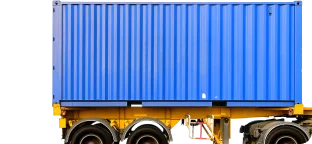
Container Transportation



















Container shipping is a method of transporting goods using standardized containers that can be transferred between different modes of transport (trucks, trains, ships) without the need to unload the contents. This approach significantly simplifies logistics, enhances cargo safety, and expedites delivery.
Rubber seals are used to ensure the air tightness of containers, preventing moisture from entering even if the container is exposed to the elements for an extended period.
Everything inside the container is protected from mechanical damage, dust, precipitation, and contamination. Special securing mechanisms ensure that containers are firmly fastened to platforms, reducing the risk of damage to the contents during transit.
The sizes of containers and their potential for additional equipment allow for the transportation of various types of goods, such as compact and oversized machinery, industrial products, food, and fertilizers. Transportation companies use differently designed equipment for container shipping.
Containers vary in size and purpose. The most common are 20-foot (6.058 meters) and 40-foot (12.192 meters) containers, referred to as TEU (Twenty-foot Equivalent Unit) and FEU (Forty-foot Equivalent Unit). Thanks to standardization, these containers can be easily transferred between different modes of transport.
The following types of containers are widely used:
- Standard (dry) containers — 20 or 40 feet in length, designed for dry cargo (e.g., textiles, equipment).
- Refrigerated containers — equipped with cooling systems for goods requiring specific temperature control (e.g., perishable foods).
- Tank containers — used for transporting liquid cargoes (e.g., chemical liquids, petroleum products).
- Open-top containers — suitable for oversized cargo due to their removable top.
- High-cube marine containers — larger in height for transporting bulk shipments. These containers are easily transferred from sea to road or rail transport.
- Flat-rack containers — 20 or 40 feet in length, with removable front and rear walls, ideal for oversized cargo.
- Pallet-wide containers — adapted for transporting Euro-pallets.
- Bulk containers — specialized for dry bulk goods (e.g., grains, powders).
Each type of cargo transportation has its own characteristics, which depend on the mode of transport.
Container Road Transport
Containerized road transport is popular due to shorter delivery times. The extensive network of highways allows for deliveries to remote locations.
Advantages of containerized road transport:
- direct delivery to a warehouse or another location specified by the recipient;
- shipping at any time of day for urgent deliveries;
- quick route adjustments;
- high-speed loading and unloading operations.
Container Rail Transport
Railway container shipping is available across the world. Some logistics companies specialize in consolidated container shipments.
Advantages of containerized rail transport:
- ability to transport oversized items;
- strict adherence to schedules regardless of weather conditions;
- lower cost compared to road and air transport.
Sea Container Shipping
Transportation companies offering sea container shipping services utilize port infrastructure. When signing contracts, it's important to plan how the goods will be delivered to the port, taking into account weather conditions and other factors affecting ship schedules.
Characteristics of the service:
- low cost;
- capacity to transport large quantities of oversized cargo;
- fast delivery speeds, especially for intercontinental shipments.
Air Container Shipping
Despite being the most expensive mode of transport, air freight is in demand when speed is more important than cost. Air transport is used to deliver goods to hard-to-reach areas, such as those in the Far North. It is suitable for transporting perishable goods, pharmaceuticals, and fragile items.
Characteristics of the service:
- rapid delivery;
- the ability to send shipments to remote locations;
- protection of valuable and fragile items from damage and theft;
- real-time tracking of vehicle location.
Multimodal Transport
Multimodal transport is often used for long-distance shipping when it’s not feasible to use a single mode of transport. Companies specializing in multimodal logistics have staff who optimize the supply chain.
Characteristics of the service:
- the ability to design an optimal delivery route using road, rail, sea routes, and other infrastructure;
- finding a balance between delivery time and cost;
- the possibility of delivering goods to and from any location, regardless of existing infrastructure.
Logistical processes in transportation companies specializing in container shipping, including road transport and other modes, are increasingly being automated. Loading and unloading operations are carried out using advanced equipment, while vehicle tracking during transit is organized through geolocation and real-time reporting. Manually, the staff primarily seal the containers, prepare accompanying documents, and provide updates to both senders and recipients.
Each company or individual entrepreneur on the Roolz platform has a detailed profile outlining their services. For instance, transportation companies that handle container shipments and own warehouses can often manage consolidated cargoes and organize multimodal transportation. Many also offer documentation support, insurance, and storage services as part of their logistics solutions.
The price largely depends on the services provided by the contractor. When determining the cost of freight transportation, the following factors are considered:
- type of cargo (this determines the type of container required)
- weight and dimensions
- mode of transport
- route
- transit
- preparation of documentation
- delivery urgency
- season
- need for insurance
💡 Customers can use the auction functionality on the Roolz platform to find the best shipping offers in one place.
On the freight exchange, you can find a carrier that not only offers competitive prices but also guarantees safe transportation and provides necessary additional services. Key selection criteria for choosing a contractor should include:
- Geography, as well as serviced ports, airports, logistics centers, and railway stations depending on the type of transport.
- The cost-to-quality ratio — price remains a key factor, but it’s also important to consider delivery times and guarantees for shipment safety.
- Transit time and routes, taking into account transshipment points — companies may use different routes, especially for international shipments.
- Service quality — such as shipment tracking, customer support, reporting, and accompanying documentation.
- Transport fleet and availability of specialized equipment — for example, when shipping items requiring specific storage conditions.
- Reputation based on contractor verification, client and partner reviews.
- Special rates for regular orders — particularly important when looking for a contractor for recurring shipments.
It’s also worth considering any additional services provided by the company, which may include transportation documentation, forwarding, dispatching, insurance, and temporary warehousing organization.
A transportation and forwarding company specializing in containerized cargo is easy to find in the Roolz directory. Add your company, find a reliable logistics partner, and conveniently organize freight transportation on the Roolz platform!
What is container shipping?
Container shipping is a method of transporting goods using standardized containers that can be transferred between different modes of transport (trucks, trains, ships) without the need to unload the contents. This approach significantly simplifies logistics, enhances cargo safety, and expedites delivery.
Rubber seals are used to ensure the air tightness of containers, preventing moisture from entering even if the container is exposed to the elements for an extended period.
Everything inside the container is protected from mechanical damage, dust, precipitation, and contamination. Special securing mechanisms ensure that containers are firmly fastened to platforms, reducing the risk of damage to the contents during transit.




Add your company


 en
en fr
fr de
de hi
hi pl
pl es
es tr
tr uk
uk